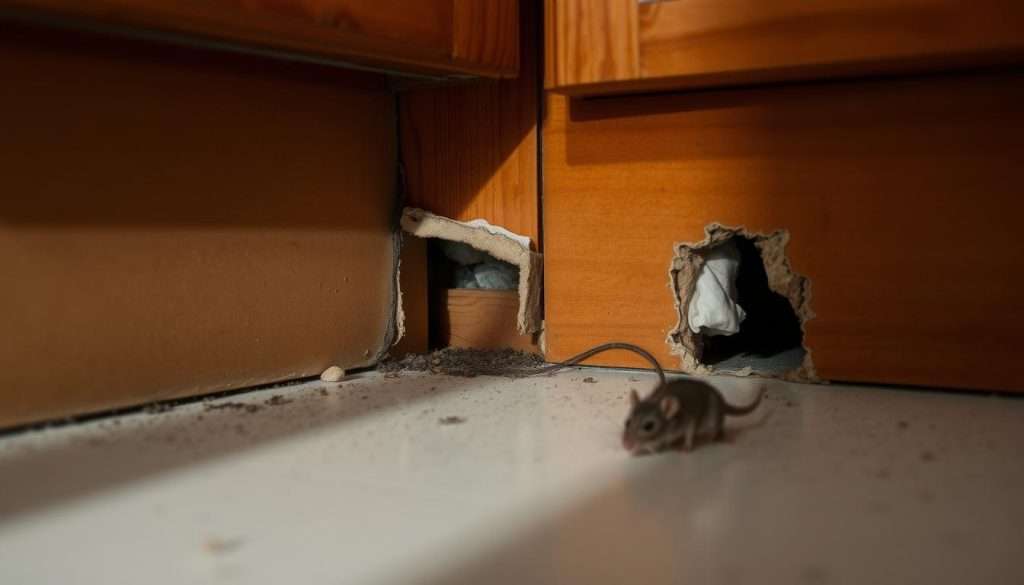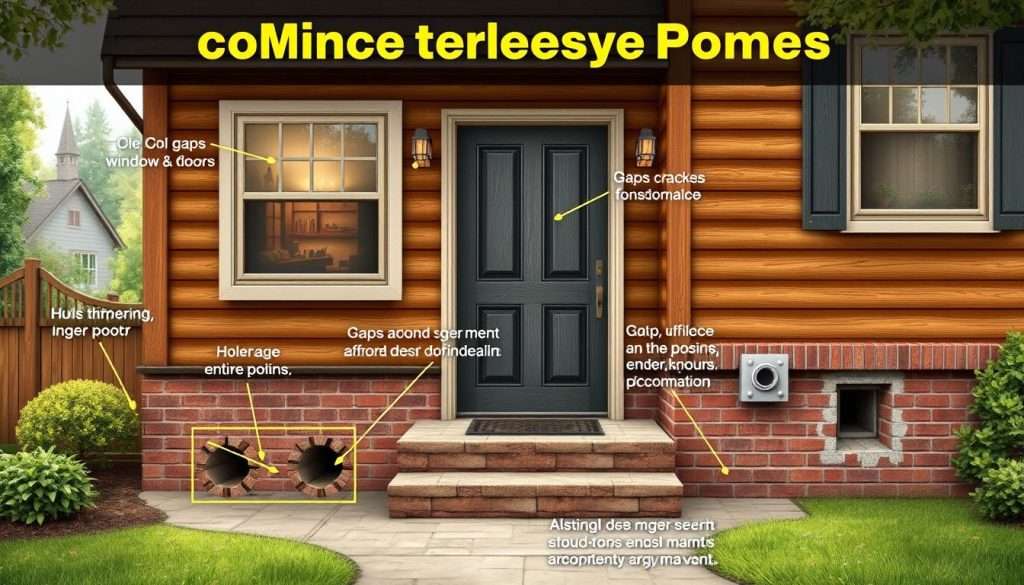Mice are common pests in homes. Knowing where they enter is key to a safe home. They can squeeze through tiny openings, like a dime. Finding these spots helps stop infestations and protects your home.
In cooler months, mice look for warmth, food, and shelter. Being alert is important for homeowners. If you see signs of mice, act fast. They can multiply quickly, leading to more problems. Clean, declutter, and seal food to keep mice away. This guide will show you how to spot mouse signs, check your home, and control mice.
Key Takeaways
- Mice can squeeze through gaps as small as a quarter of an inch.
- Rodent invasions are common during cooler seasons due to their search for warmth.
- Regular inspections of the attic can help prevent mice from entering your home.
- Cleaning and decluttering can lower the risk of infestations by eliminating hiding spots.
- Using steel wool or aluminum mesh is an effective way to seal small gaps around your house.
- Quick action is needed upon detecting signs of a mouse infestation to prevent escalation.
- Professional pest control services are increasingly sought after for effective mice prevention.
Understanding the Importance of Identifying Mice Entry Points
Finding where mice get in is key to keeping them out. Mice can fit through tiny holes, like a dime. So, it’s important to check your home well.
Ignoring these spots can cause big problems. Rodents chew on wires, insulation, and wood. This can lead to fires and cost a lot to fix.
Spotting mouse signs early is crucial. Look for droppings, chewed wires, and nests. These signs mean mice are around. Catching them early stops big problems.
Using special tools like thermal cameras and ultrasonic detectors helps. They find hidden spots where mice get in. Pest experts also suggest using steel wool and caulking to block mice.
Knowing where mice can get in is important. This keeps your home pest-free. Common spots include:
- Cracks in the foundation
- Gaps around windows and doors
- Utility lines and vents
Try sprinkling flour or talcum powder to see mouse tracks. Being proactive keeps your home safe and healthy.
Signs of Mice Infestation to Look For
Knowing the signs of mice infestation helps you act fast. Spotting these signs can protect your home and family. It keeps you safe from health risks that mice can bring.
Mice Droppings and What They Indicate
Mice droppings are small and dark. They are usually 1/8 to 1/4 inch long. Seeing many droppings means mice are around.
You might find 50 to 80 droppings in one night. Droppings in your home show mice are there. Yellow stains from urine can mean a big problem.
Mice Sounds and Their Meaning
Mice are most active at night. You might hear them scratching or scurrying in walls or ceilings. Hearing these sounds means mice are nearby.
If you see mice during the day, it’s a big problem. This means you need to act fast.
Visual Signs: Mice Tracks and Nests
Look at corners and baseboards for signs. Gnaw marks on items show mice are nesting. They leave four-toed prints with their front feet and five-toed prints with their hind feet.
Nests are made from shredded paper or fabric. They hide in lofts, attics, or cupboards. Seeing these signs helps you understand the problem.

Spotting these signs early helps you manage the problem. For more info, check out this guide on mice infestation signs.
How to Find Out Where Mice Are Getting in Your House
To find out where mice are getting in, you need to check both inside and outside your house. Start by looking at common spots where mice might come in. Make sure to check every possible entry point.
Conducting a Comprehensive Inspection
It’s important to do a thorough check to find where mice are getting in. Look at these areas:
- Check around pipes and vents for gaps.
- Look for cracks around doors and windows.
- Inspect areas like attics and basements, as these provide easy entry.
- Pay attention to high-risk zones like kitchens and laundry rooms.
- Feel for drafts in suspected areas to identify hidden entry points.
- Look for mouse droppings, which typically resemble small black grains.
Identifying Common Entry Points in Your Home
Knowing where mice usually come in can help you find them. Mice can fit through tiny openings, so check even the smallest gaps. Look at these common spots:
- Gaps in the foundation where pipes enter.
- Openings in and around garages.
- Vents and ducts that lack appropriate sealing.
- Crawl spaces and attics where insulation may be disturbed.
Also, watch for oily rub marks on walls, which show where mice have been. Drafty spots, black marks around pipe gaps, and hidden urine smells are also clues. They help you figure out where mice are getting in.
| Common Entry Points | Description | Detection Tips |
|---|---|---|
| Foundation Gaps | Spaces where pipes enter the foundation | Look for gaps in the concrete |
| Garages | Doors and windows that may not close properly | Check for visible cracks or holes |
| Vents and Ducts | Areas that may lack proper sealing | Inspect for loose covers or cracks |
| Crawl Spaces and Attics | Hiding places that provide easy access inside | Look for disturbed insulation or droppings |
Common Mice Entry Points
Mice can fit through tiny openings, like a nickel. It’s key to find and block these spots around your home. Knowing where mice come in helps you stop them before they start.
Exterior Entry Points
Outside, mice sneak in through different weak spots. Look for:
- Gaps in the foundation
- Openings around pipes, gas lines, and electrical wiring
- Worn-out weather stripping around doors and windows
- Access through the attic or roof
- Ventilation systems and airways
Fixing these spots outside can keep mice out of your home.
Interior Entry Points
Inside, mice find cozy spots through many entry points. Check:
- Spaces behind appliances and inside cabinets
- Gaps around plumbing and utility lines
- Holes in walls or ceilings
- Cracks in baseboards
- Areas under sinks or near drains
Watching these spots closely can catch mice early.
Areas at Risk: Vents and Utility Lines
Vents and utility lines are big risks for mice getting in. They use these paths to get into homes. Regular checks are important. Look at:
- Vents and ductwork
- Openings around HVAC systems
- Utility openings where pipes enter your home

Conducting Exterior Inspections to Identify Entry Points
It’s important to check your home’s outside to find where mice might get in. Walking around your house helps you spot weak spots. Look at where different materials meet, like brick and wood. These areas often have cracks and gaps that mice can use to get in.
- Foundation Cracks: Check your foundation for cracks bigger than a quarter of an inch. Mice can fit through very small openings.
- Door and Window Seals: Make sure doors and windows are sealed well. Gaps here let mice easily get in.
- Garage and Siding: Check the garage door area. It’s a common spot for mice, especially if it’s not well-maintained.
- Vents and Utility Pipes: Look at areas near vents and utility lines. These spots can be entry points that need a close look.
When you’re checking, remember to:
- Look at attics and basements for damage. These places are less visited and might attract mice.
- Check exterior walls for small holes, especially where insulation might be damaged.
- Make sure weep holes in brickwork are clean and sealed to keep mice out.
- Watch out for ivy or other plants that might help mice reach your home.
To keep mice away, seal any entry points you find. Use materials like steel wool, caulk, and expanding foam. By taking action during your inspections, you can lower the chance of mice getting into your home.
Securing Your Home: Preventing Mice from Entering
To keep mice out, sealing your home well is key. Mice can fit through tiny spaces, like a dime or 6mm. It’s important to block these small openings to keep your home safe.
Effective Sealing Methods
First, check your home for holes, cracks, or gaps. Sealing these spots with strong materials helps a lot. Here are some good choices:
- Steel wool: It’s hard for mice to chew through, great for small holes.
- Copper mesh: A tough option for keeping mice out.
- Caulk: Good for sealing cracks in walls and around windows.
- Wood putty or metal sheeting: Best for bigger gaps for a lasting fix.
Don’t forget to seal vents and utility lines too. This makes it harder for mice to get in.
Using the Right Materials for Long-Term Solutions
Choosing the right materials is crucial for keeping mice away for good. Here are some top picks:
- Cement: Great for fixing big holes in the foundation.
- Heavy-duty plastic containers: Keep food safe from mice.
- Trash cans: Need tight lids to keep mice away.
By using these tips and sealing methods, you can keep your home mouse-free.
Mice Control Methods You Can Implement
If you see signs of mice, you must act fast. There are many ways to control mice in your home.
Traps: Snap traps are quick, while live traps let you move mice away. Many people choose these because they are easy to use and work fast.
Rodenticides: Be careful with these. Always follow local rules to keep your family and pets safe. Using them with traps can help a lot.
For tough cases, you might need a pest control expert. They know how to handle mice problems well.
Mice prevention tips help keep your home mouse-free. Clean up food and store it right. Use steel wool or copper mesh to block mice from getting in.
Many products claim to keep mice away, but most don’t work. A good plan includes traps, blocking their way, and keeping your home clean. This will keep your home safe from mice.
Conclusion
Learning how to find out where mice are getting in your house is key for homeowners. Regular checks to spot and block entry points can lower the chance of mice. Mice can fit through tiny gaps, so it’s important to act fast.
Using copper-wire mesh and steel wool to block holes is a good long-term plan. Also, making your home less appealing to mice can stop a small issue from getting bigger. This is especially true in places like Maryland during winter.
Stay alert and use guides or infographics for mouse control. This way, you can keep your home mouse-free. The best way to keep your home in good shape is to act early.
